Macroeconomics Report: Fiscal, Monetary Policies and Economic Growth
VerifiedAdded on 2020/04/15
|12
|2536
|80
Report
AI Summary
This report provides an analysis of expansionary fiscal and monetary policies implemented by the Federal Government and the Federal Reserve. It examines the actions taken in terms of taxes, government spending, reserve ratio, discount rate, and open market operations. The report details how these policies influence aggregate demand, GDP, employment, money supply, and interest rates. It explores the effects of these policies on economic indicators, emphasizing the tools used by the Federal Reserve and the government's role in stabilizing and stimulating economic growth during recessionary phases. The report concludes by summarizing the impacts of these policies on various economic factors, including consumer expenditure and investment, and their overall effect on the economy.
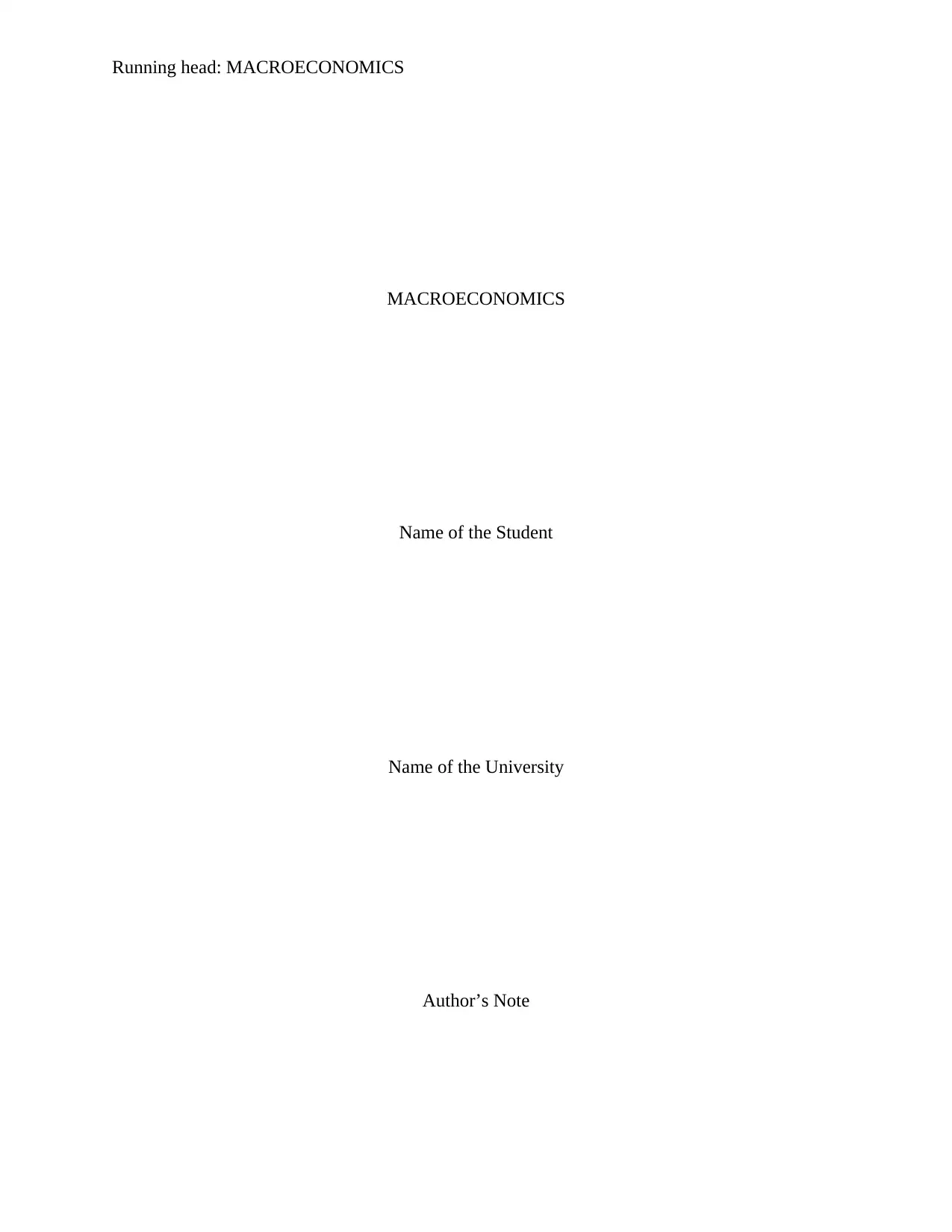
Running head: MACROECONOMICS
MACROECONOMICS
Name of the Student
Name of the University
Author’s Note
MACROECONOMICS
Name of the Student
Name of the University
Author’s Note
Paraphrase This Document
Need a fresh take? Get an instant paraphrase of this document with our AI Paraphraser

1MACROECONOMICS
Table of contents
Introduction......................................................................................................................................2
Actions taken by Federal government while engaging in expansionary fiscal policy in terms of
taxes and government spending.......................................................................................................2
Effect on aggregate demand, GDP and employment.......................................................................3
Actions taken by Federal Reserve Bank in regard to reserve ratio, discount rate, open market
operations.........................................................................................................................................5
Actions of the Federal Bank influencing the money supply, interest rates, spending, aggregate
demand, GDP and employment.......................................................................................................7
Conclusion.......................................................................................................................................8
References......................................................................................................................................10
Table of contents
Introduction......................................................................................................................................2
Actions taken by Federal government while engaging in expansionary fiscal policy in terms of
taxes and government spending.......................................................................................................2
Effect on aggregate demand, GDP and employment.......................................................................3
Actions taken by Federal Reserve Bank in regard to reserve ratio, discount rate, open market
operations.........................................................................................................................................5
Actions of the Federal Bank influencing the money supply, interest rates, spending, aggregate
demand, GDP and employment.......................................................................................................7
Conclusion.......................................................................................................................................8
References......................................................................................................................................10
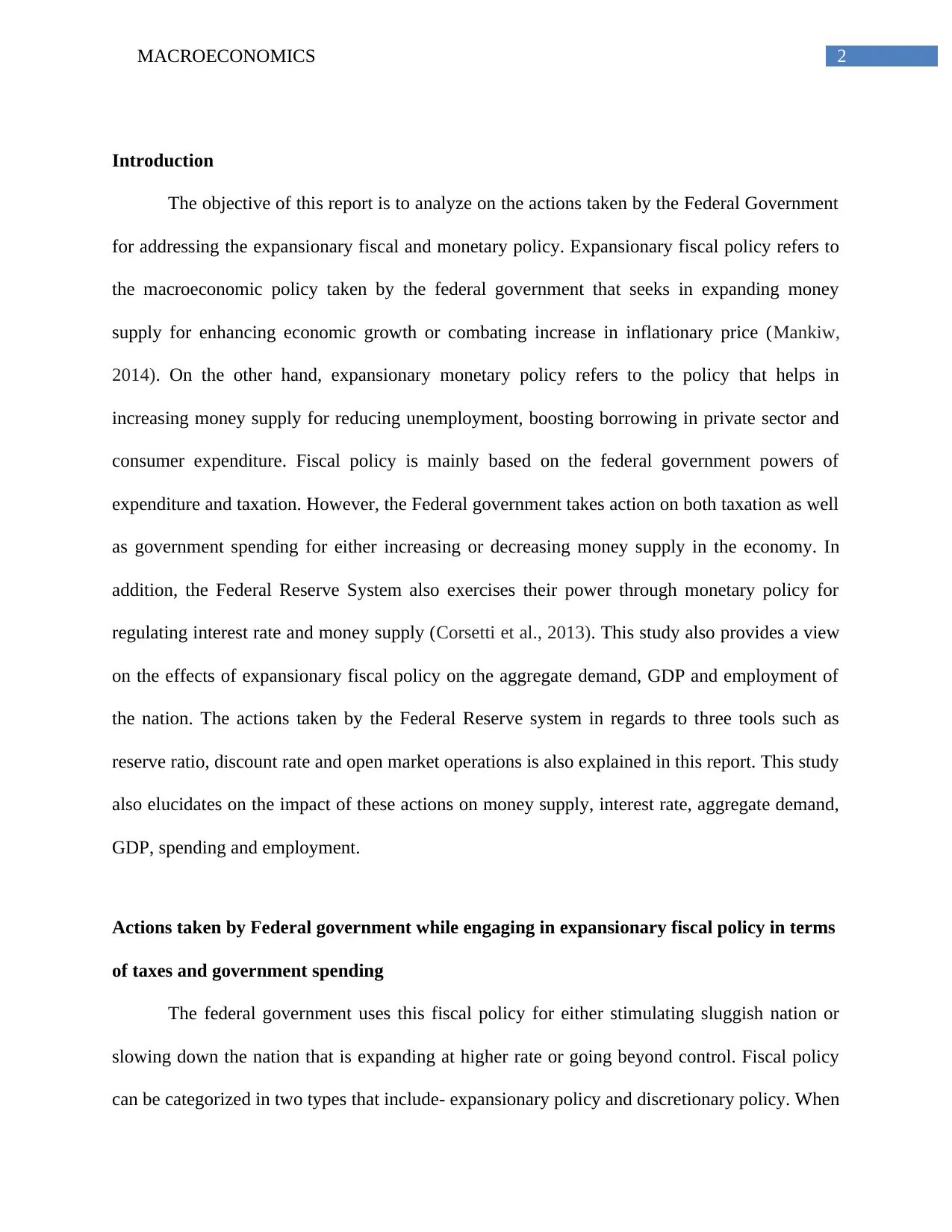
2MACROECONOMICS
Introduction
The objective of this report is to analyze on the actions taken by the Federal Government
for addressing the expansionary fiscal and monetary policy. Expansionary fiscal policy refers to
the macroeconomic policy taken by the federal government that seeks in expanding money
supply for enhancing economic growth or combating increase in inflationary price (Mankiw,
2014). On the other hand, expansionary monetary policy refers to the policy that helps in
increasing money supply for reducing unemployment, boosting borrowing in private sector and
consumer expenditure. Fiscal policy is mainly based on the federal government powers of
expenditure and taxation. However, the Federal government takes action on both taxation as well
as government spending for either increasing or decreasing money supply in the economy. In
addition, the Federal Reserve System also exercises their power through monetary policy for
regulating interest rate and money supply (Corsetti et al., 2013). This study also provides a view
on the effects of expansionary fiscal policy on the aggregate demand, GDP and employment of
the nation. The actions taken by the Federal Reserve system in regards to three tools such as
reserve ratio, discount rate and open market operations is also explained in this report. This study
also elucidates on the impact of these actions on money supply, interest rate, aggregate demand,
GDP, spending and employment.
Actions taken by Federal government while engaging in expansionary fiscal policy in terms
of taxes and government spending
The federal government uses this fiscal policy for either stimulating sluggish nation or
slowing down the nation that is expanding at higher rate or going beyond control. Fiscal policy
can be categorized in two types that include- expansionary policy and discretionary policy. When
Introduction
The objective of this report is to analyze on the actions taken by the Federal Government
for addressing the expansionary fiscal and monetary policy. Expansionary fiscal policy refers to
the macroeconomic policy taken by the federal government that seeks in expanding money
supply for enhancing economic growth or combating increase in inflationary price (Mankiw,
2014). On the other hand, expansionary monetary policy refers to the policy that helps in
increasing money supply for reducing unemployment, boosting borrowing in private sector and
consumer expenditure. Fiscal policy is mainly based on the federal government powers of
expenditure and taxation. However, the Federal government takes action on both taxation as well
as government spending for either increasing or decreasing money supply in the economy. In
addition, the Federal Reserve System also exercises their power through monetary policy for
regulating interest rate and money supply (Corsetti et al., 2013). This study also provides a view
on the effects of expansionary fiscal policy on the aggregate demand, GDP and employment of
the nation. The actions taken by the Federal Reserve system in regards to three tools such as
reserve ratio, discount rate and open market operations is also explained in this report. This study
also elucidates on the impact of these actions on money supply, interest rate, aggregate demand,
GDP, spending and employment.
Actions taken by Federal government while engaging in expansionary fiscal policy in terms
of taxes and government spending
The federal government uses this fiscal policy for either stimulating sluggish nation or
slowing down the nation that is expanding at higher rate or going beyond control. Fiscal policy
can be categorized in two types that include- expansionary policy and discretionary policy. When
⊘ This is a preview!⊘
Do you want full access?
Subscribe today to unlock all pages.

Trusted by 1+ million students worldwide
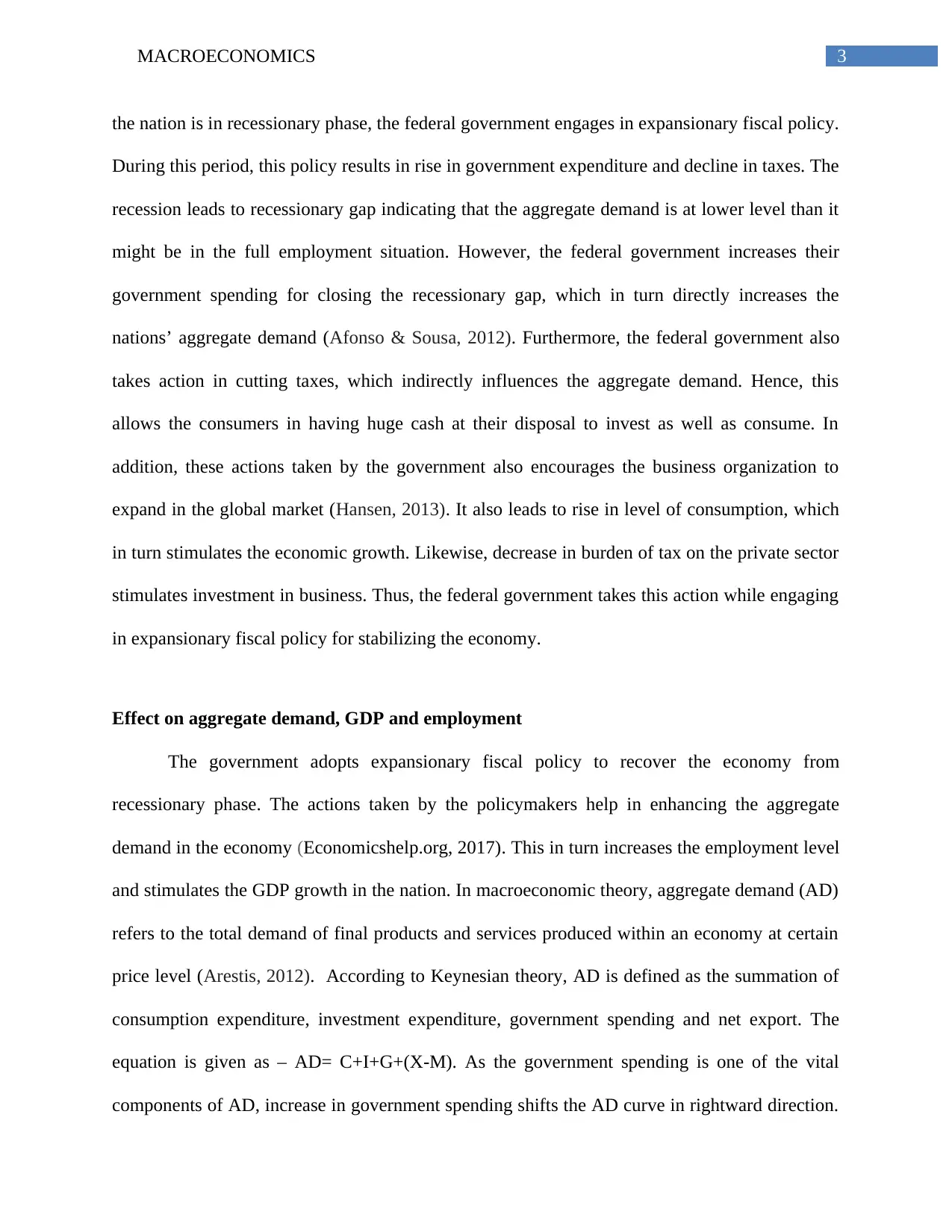
3MACROECONOMICS
the nation is in recessionary phase, the federal government engages in expansionary fiscal policy.
During this period, this policy results in rise in government expenditure and decline in taxes. The
recession leads to recessionary gap indicating that the aggregate demand is at lower level than it
might be in the full employment situation. However, the federal government increases their
government spending for closing the recessionary gap, which in turn directly increases the
nations’ aggregate demand (Afonso & Sousa, 2012). Furthermore, the federal government also
takes action in cutting taxes, which indirectly influences the aggregate demand. Hence, this
allows the consumers in having huge cash at their disposal to invest as well as consume. In
addition, these actions taken by the government also encourages the business organization to
expand in the global market (Hansen, 2013). It also leads to rise in level of consumption, which
in turn stimulates the economic growth. Likewise, decrease in burden of tax on the private sector
stimulates investment in business. Thus, the federal government takes this action while engaging
in expansionary fiscal policy for stabilizing the economy.
Effect on aggregate demand, GDP and employment
The government adopts expansionary fiscal policy to recover the economy from
recessionary phase. The actions taken by the policymakers help in enhancing the aggregate
demand in the economy (Economicshelp.org, 2017). This in turn increases the employment level
and stimulates the GDP growth in the nation. In macroeconomic theory, aggregate demand (AD)
refers to the total demand of final products and services produced within an economy at certain
price level (Arestis, 2012). According to Keynesian theory, AD is defined as the summation of
consumption expenditure, investment expenditure, government spending and net export. The
equation is given as – AD= C+I+G+(X-M). As the government spending is one of the vital
components of AD, increase in government spending shifts the AD curve in rightward direction.
the nation is in recessionary phase, the federal government engages in expansionary fiscal policy.
During this period, this policy results in rise in government expenditure and decline in taxes. The
recession leads to recessionary gap indicating that the aggregate demand is at lower level than it
might be in the full employment situation. However, the federal government increases their
government spending for closing the recessionary gap, which in turn directly increases the
nations’ aggregate demand (Afonso & Sousa, 2012). Furthermore, the federal government also
takes action in cutting taxes, which indirectly influences the aggregate demand. Hence, this
allows the consumers in having huge cash at their disposal to invest as well as consume. In
addition, these actions taken by the government also encourages the business organization to
expand in the global market (Hansen, 2013). It also leads to rise in level of consumption, which
in turn stimulates the economic growth. Likewise, decrease in burden of tax on the private sector
stimulates investment in business. Thus, the federal government takes this action while engaging
in expansionary fiscal policy for stabilizing the economy.
Effect on aggregate demand, GDP and employment
The government adopts expansionary fiscal policy to recover the economy from
recessionary phase. The actions taken by the policymakers help in enhancing the aggregate
demand in the economy (Economicshelp.org, 2017). This in turn increases the employment level
and stimulates the GDP growth in the nation. In macroeconomic theory, aggregate demand (AD)
refers to the total demand of final products and services produced within an economy at certain
price level (Arestis, 2012). According to Keynesian theory, AD is defined as the summation of
consumption expenditure, investment expenditure, government spending and net export. The
equation is given as – AD= C+I+G+(X-M). As the government spending is one of the vital
components of AD, increase in government spending shifts the AD curve in rightward direction.
Paraphrase This Document
Need a fresh take? Get an instant paraphrase of this document with our AI Paraphraser
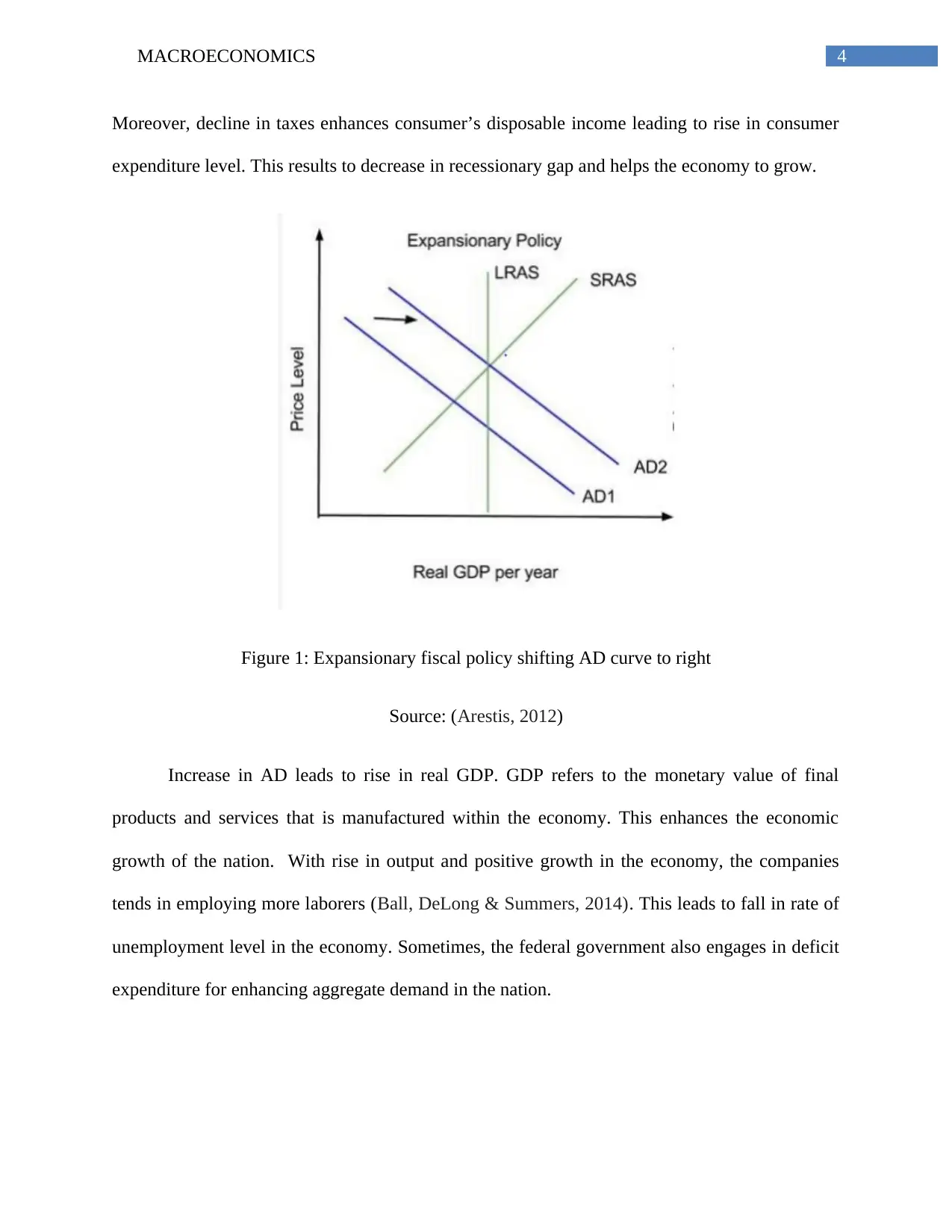
4MACROECONOMICS
Moreover, decline in taxes enhances consumer’s disposable income leading to rise in consumer
expenditure level. This results to decrease in recessionary gap and helps the economy to grow.
Figure 1: Expansionary fiscal policy shifting AD curve to right
Source: (Arestis, 2012)
Increase in AD leads to rise in real GDP. GDP refers to the monetary value of final
products and services that is manufactured within the economy. This enhances the economic
growth of the nation. With rise in output and positive growth in the economy, the companies
tends in employing more laborers (Ball, DeLong & Summers, 2014). This leads to fall in rate of
unemployment level in the economy. Sometimes, the federal government also engages in deficit
expenditure for enhancing aggregate demand in the nation.
Moreover, decline in taxes enhances consumer’s disposable income leading to rise in consumer
expenditure level. This results to decrease in recessionary gap and helps the economy to grow.
Figure 1: Expansionary fiscal policy shifting AD curve to right
Source: (Arestis, 2012)
Increase in AD leads to rise in real GDP. GDP refers to the monetary value of final
products and services that is manufactured within the economy. This enhances the economic
growth of the nation. With rise in output and positive growth in the economy, the companies
tends in employing more laborers (Ball, DeLong & Summers, 2014). This leads to fall in rate of
unemployment level in the economy. Sometimes, the federal government also engages in deficit
expenditure for enhancing aggregate demand in the nation.
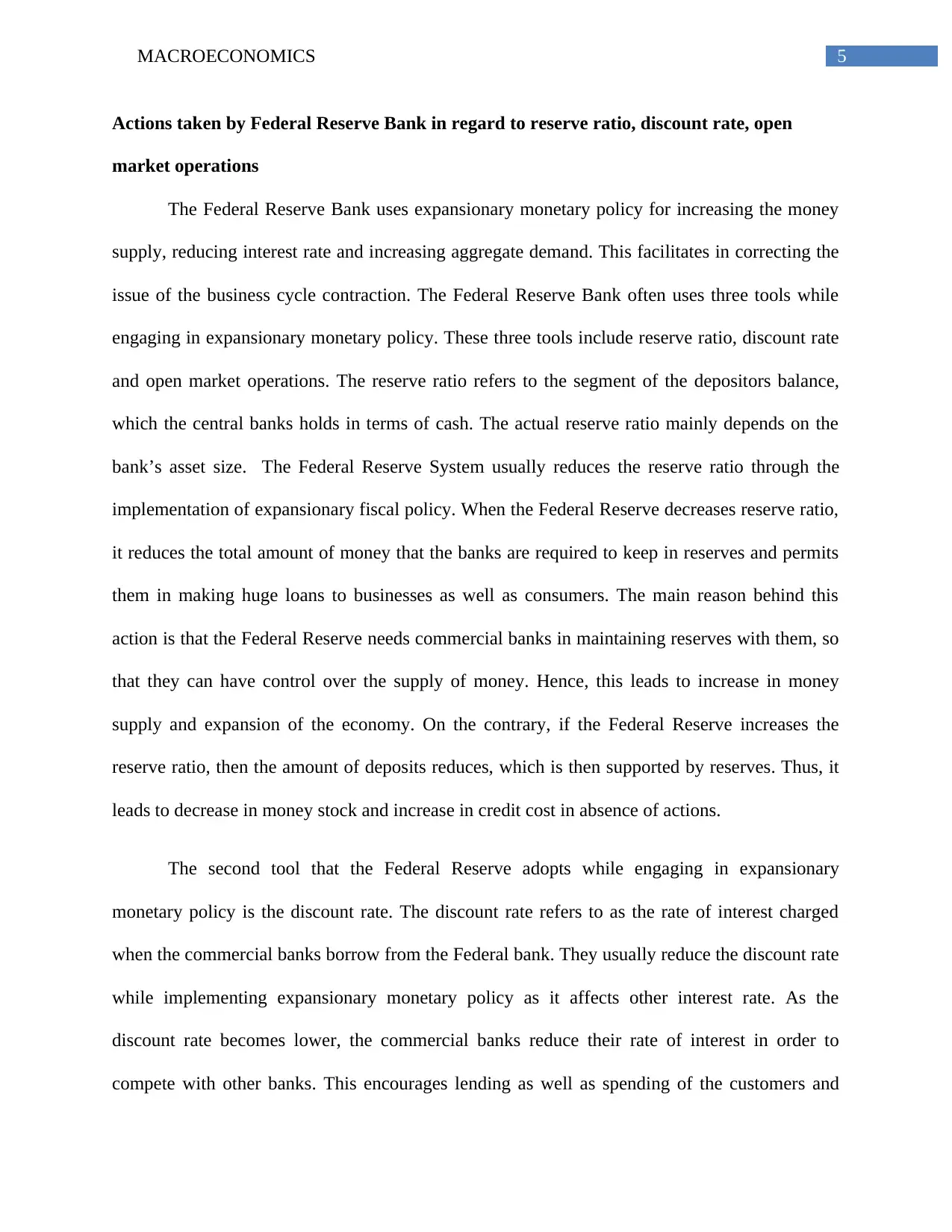
5MACROECONOMICS
Actions taken by Federal Reserve Bank in regard to reserve ratio, discount rate, open
market operations
The Federal Reserve Bank uses expansionary monetary policy for increasing the money
supply, reducing interest rate and increasing aggregate demand. This facilitates in correcting the
issue of the business cycle contraction. The Federal Reserve Bank often uses three tools while
engaging in expansionary monetary policy. These three tools include reserve ratio, discount rate
and open market operations. The reserve ratio refers to the segment of the depositors balance,
which the central banks holds in terms of cash. The actual reserve ratio mainly depends on the
bank’s asset size. The Federal Reserve System usually reduces the reserve ratio through the
implementation of expansionary fiscal policy. When the Federal Reserve decreases reserve ratio,
it reduces the total amount of money that the banks are required to keep in reserves and permits
them in making huge loans to businesses as well as consumers. The main reason behind this
action is that the Federal Reserve needs commercial banks in maintaining reserves with them, so
that they can have control over the supply of money. Hence, this leads to increase in money
supply and expansion of the economy. On the contrary, if the Federal Reserve increases the
reserve ratio, then the amount of deposits reduces, which is then supported by reserves. Thus, it
leads to decrease in money stock and increase in credit cost in absence of actions.
The second tool that the Federal Reserve adopts while engaging in expansionary
monetary policy is the discount rate. The discount rate refers to as the rate of interest charged
when the commercial banks borrow from the Federal bank. They usually reduce the discount rate
while implementing expansionary monetary policy as it affects other interest rate. As the
discount rate becomes lower, the commercial banks reduce their rate of interest in order to
compete with other banks. This encourages lending as well as spending of the customers and
Actions taken by Federal Reserve Bank in regard to reserve ratio, discount rate, open
market operations
The Federal Reserve Bank uses expansionary monetary policy for increasing the money
supply, reducing interest rate and increasing aggregate demand. This facilitates in correcting the
issue of the business cycle contraction. The Federal Reserve Bank often uses three tools while
engaging in expansionary monetary policy. These three tools include reserve ratio, discount rate
and open market operations. The reserve ratio refers to the segment of the depositors balance,
which the central banks holds in terms of cash. The actual reserve ratio mainly depends on the
bank’s asset size. The Federal Reserve System usually reduces the reserve ratio through the
implementation of expansionary fiscal policy. When the Federal Reserve decreases reserve ratio,
it reduces the total amount of money that the banks are required to keep in reserves and permits
them in making huge loans to businesses as well as consumers. The main reason behind this
action is that the Federal Reserve needs commercial banks in maintaining reserves with them, so
that they can have control over the supply of money. Hence, this leads to increase in money
supply and expansion of the economy. On the contrary, if the Federal Reserve increases the
reserve ratio, then the amount of deposits reduces, which is then supported by reserves. Thus, it
leads to decrease in money stock and increase in credit cost in absence of actions.
The second tool that the Federal Reserve adopts while engaging in expansionary
monetary policy is the discount rate. The discount rate refers to as the rate of interest charged
when the commercial banks borrow from the Federal bank. They usually reduce the discount rate
while implementing expansionary monetary policy as it affects other interest rate. As the
discount rate becomes lower, the commercial banks reduce their rate of interest in order to
compete with other banks. This encourages lending as well as spending of the customers and
⊘ This is a preview!⊘
Do you want full access?
Subscribe today to unlock all pages.

Trusted by 1+ million students worldwide
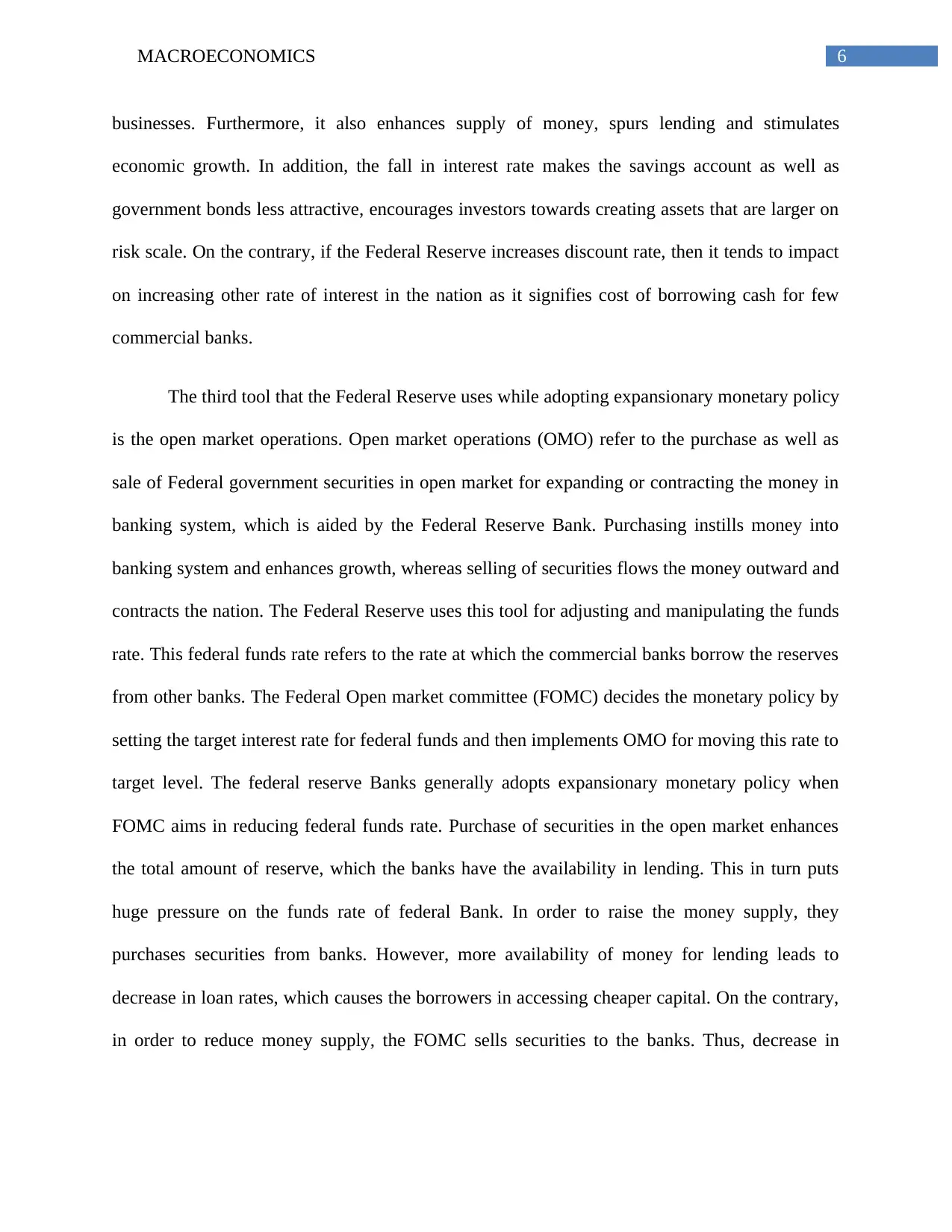
6MACROECONOMICS
businesses. Furthermore, it also enhances supply of money, spurs lending and stimulates
economic growth. In addition, the fall in interest rate makes the savings account as well as
government bonds less attractive, encourages investors towards creating assets that are larger on
risk scale. On the contrary, if the Federal Reserve increases discount rate, then it tends to impact
on increasing other rate of interest in the nation as it signifies cost of borrowing cash for few
commercial banks.
The third tool that the Federal Reserve uses while adopting expansionary monetary policy
is the open market operations. Open market operations (OMO) refer to the purchase as well as
sale of Federal government securities in open market for expanding or contracting the money in
banking system, which is aided by the Federal Reserve Bank. Purchasing instills money into
banking system and enhances growth, whereas selling of securities flows the money outward and
contracts the nation. The Federal Reserve uses this tool for adjusting and manipulating the funds
rate. This federal funds rate refers to the rate at which the commercial banks borrow the reserves
from other banks. The Federal Open market committee (FOMC) decides the monetary policy by
setting the target interest rate for federal funds and then implements OMO for moving this rate to
target level. The federal reserve Banks generally adopts expansionary monetary policy when
FOMC aims in reducing federal funds rate. Purchase of securities in the open market enhances
the total amount of reserve, which the banks have the availability in lending. This in turn puts
huge pressure on the funds rate of federal Bank. In order to raise the money supply, they
purchases securities from banks. However, more availability of money for lending leads to
decrease in loan rates, which causes the borrowers in accessing cheaper capital. On the contrary,
in order to reduce money supply, the FOMC sells securities to the banks. Thus, decrease in
businesses. Furthermore, it also enhances supply of money, spurs lending and stimulates
economic growth. In addition, the fall in interest rate makes the savings account as well as
government bonds less attractive, encourages investors towards creating assets that are larger on
risk scale. On the contrary, if the Federal Reserve increases discount rate, then it tends to impact
on increasing other rate of interest in the nation as it signifies cost of borrowing cash for few
commercial banks.
The third tool that the Federal Reserve uses while adopting expansionary monetary policy
is the open market operations. Open market operations (OMO) refer to the purchase as well as
sale of Federal government securities in open market for expanding or contracting the money in
banking system, which is aided by the Federal Reserve Bank. Purchasing instills money into
banking system and enhances growth, whereas selling of securities flows the money outward and
contracts the nation. The Federal Reserve uses this tool for adjusting and manipulating the funds
rate. This federal funds rate refers to the rate at which the commercial banks borrow the reserves
from other banks. The Federal Open market committee (FOMC) decides the monetary policy by
setting the target interest rate for federal funds and then implements OMO for moving this rate to
target level. The federal reserve Banks generally adopts expansionary monetary policy when
FOMC aims in reducing federal funds rate. Purchase of securities in the open market enhances
the total amount of reserve, which the banks have the availability in lending. This in turn puts
huge pressure on the funds rate of federal Bank. In order to raise the money supply, they
purchases securities from banks. However, more availability of money for lending leads to
decrease in loan rates, which causes the borrowers in accessing cheaper capital. On the contrary,
in order to reduce money supply, the FOMC sells securities to the banks. Thus, decrease in
Paraphrase This Document
Need a fresh take? Get an instant paraphrase of this document with our AI Paraphraser
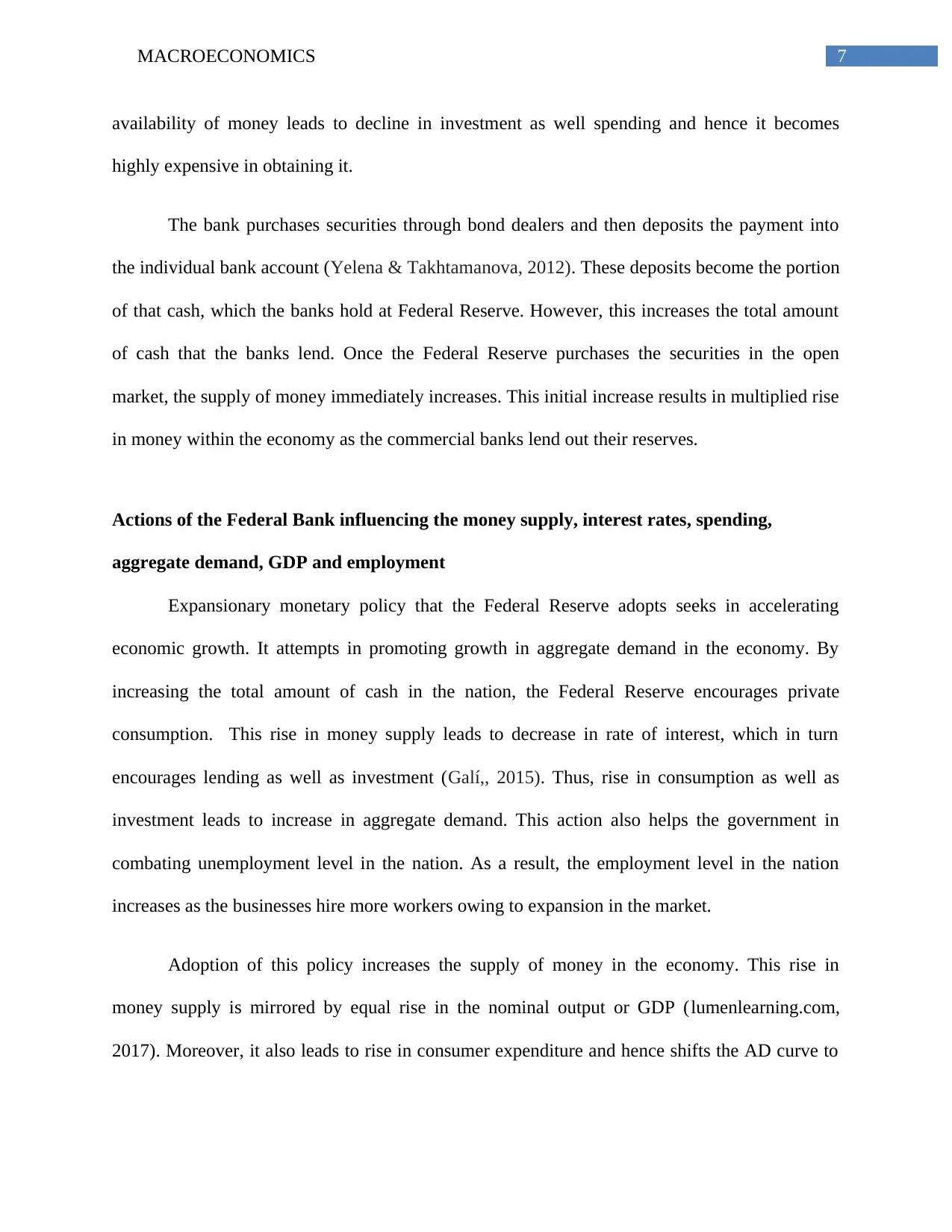
7MACROECONOMICS
availability of money leads to decline in investment as well spending and hence it becomes
highly expensive in obtaining it.
The bank purchases securities through bond dealers and then deposits the payment into
the individual bank account (Yelena & Takhtamanova, 2012). These deposits become the portion
of that cash, which the banks hold at Federal Reserve. However, this increases the total amount
of cash that the banks lend. Once the Federal Reserve purchases the securities in the open
market, the supply of money immediately increases. This initial increase results in multiplied rise
in money within the economy as the commercial banks lend out their reserves.
Actions of the Federal Bank influencing the money supply, interest rates, spending,
aggregate demand, GDP and employment
Expansionary monetary policy that the Federal Reserve adopts seeks in accelerating
economic growth. It attempts in promoting growth in aggregate demand in the economy. By
increasing the total amount of cash in the nation, the Federal Reserve encourages private
consumption. This rise in money supply leads to decrease in rate of interest, which in turn
encourages lending as well as investment (Galí,, 2015). Thus, rise in consumption as well as
investment leads to increase in aggregate demand. This action also helps the government in
combating unemployment level in the nation. As a result, the employment level in the nation
increases as the businesses hire more workers owing to expansion in the market.
Adoption of this policy increases the supply of money in the economy. This rise in
money supply is mirrored by equal rise in the nominal output or GDP (lumenlearning.com,
2017). Moreover, it also leads to rise in consumer expenditure and hence shifts the AD curve to
availability of money leads to decline in investment as well spending and hence it becomes
highly expensive in obtaining it.
The bank purchases securities through bond dealers and then deposits the payment into
the individual bank account (Yelena & Takhtamanova, 2012). These deposits become the portion
of that cash, which the banks hold at Federal Reserve. However, this increases the total amount
of cash that the banks lend. Once the Federal Reserve purchases the securities in the open
market, the supply of money immediately increases. This initial increase results in multiplied rise
in money within the economy as the commercial banks lend out their reserves.
Actions of the Federal Bank influencing the money supply, interest rates, spending,
aggregate demand, GDP and employment
Expansionary monetary policy that the Federal Reserve adopts seeks in accelerating
economic growth. It attempts in promoting growth in aggregate demand in the economy. By
increasing the total amount of cash in the nation, the Federal Reserve encourages private
consumption. This rise in money supply leads to decrease in rate of interest, which in turn
encourages lending as well as investment (Galí,, 2015). Thus, rise in consumption as well as
investment leads to increase in aggregate demand. This action also helps the government in
combating unemployment level in the nation. As a result, the employment level in the nation
increases as the businesses hire more workers owing to expansion in the market.
Adoption of this policy increases the supply of money in the economy. This rise in
money supply is mirrored by equal rise in the nominal output or GDP (lumenlearning.com,
2017). Moreover, it also leads to rise in consumer expenditure and hence shifts the AD curve to
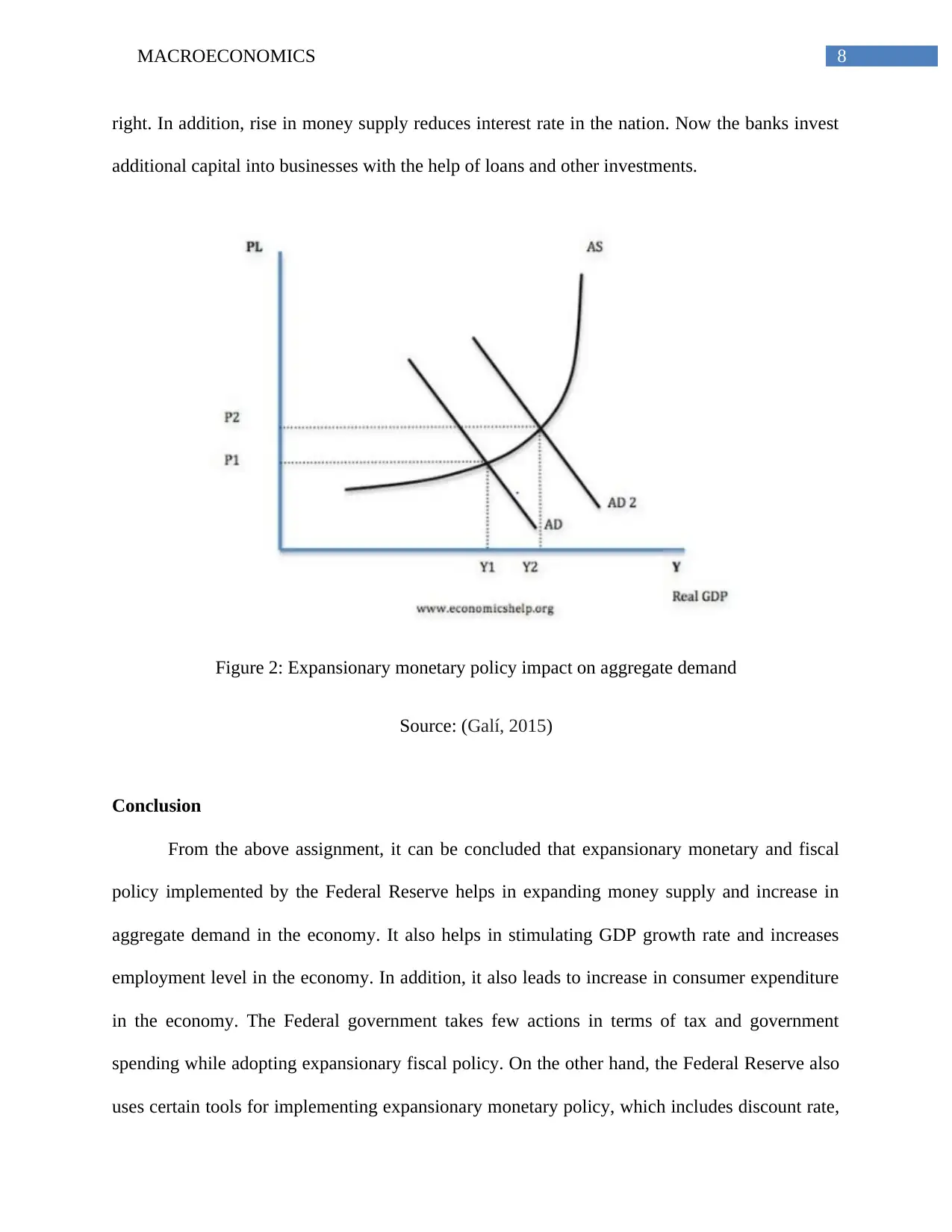
8MACROECONOMICS
right. In addition, rise in money supply reduces interest rate in the nation. Now the banks invest
additional capital into businesses with the help of loans and other investments.
Figure 2: Expansionary monetary policy impact on aggregate demand
Source: (Galí, 2015)
Conclusion
From the above assignment, it can be concluded that expansionary monetary and fiscal
policy implemented by the Federal Reserve helps in expanding money supply and increase in
aggregate demand in the economy. It also helps in stimulating GDP growth rate and increases
employment level in the economy. In addition, it also leads to increase in consumer expenditure
in the economy. The Federal government takes few actions in terms of tax and government
spending while adopting expansionary fiscal policy. On the other hand, the Federal Reserve also
uses certain tools for implementing expansionary monetary policy, which includes discount rate,
right. In addition, rise in money supply reduces interest rate in the nation. Now the banks invest
additional capital into businesses with the help of loans and other investments.
Figure 2: Expansionary monetary policy impact on aggregate demand
Source: (Galí, 2015)
Conclusion
From the above assignment, it can be concluded that expansionary monetary and fiscal
policy implemented by the Federal Reserve helps in expanding money supply and increase in
aggregate demand in the economy. It also helps in stimulating GDP growth rate and increases
employment level in the economy. In addition, it also leads to increase in consumer expenditure
in the economy. The Federal government takes few actions in terms of tax and government
spending while adopting expansionary fiscal policy. On the other hand, the Federal Reserve also
uses certain tools for implementing expansionary monetary policy, which includes discount rate,
⊘ This is a preview!⊘
Do you want full access?
Subscribe today to unlock all pages.

Trusted by 1+ million students worldwide
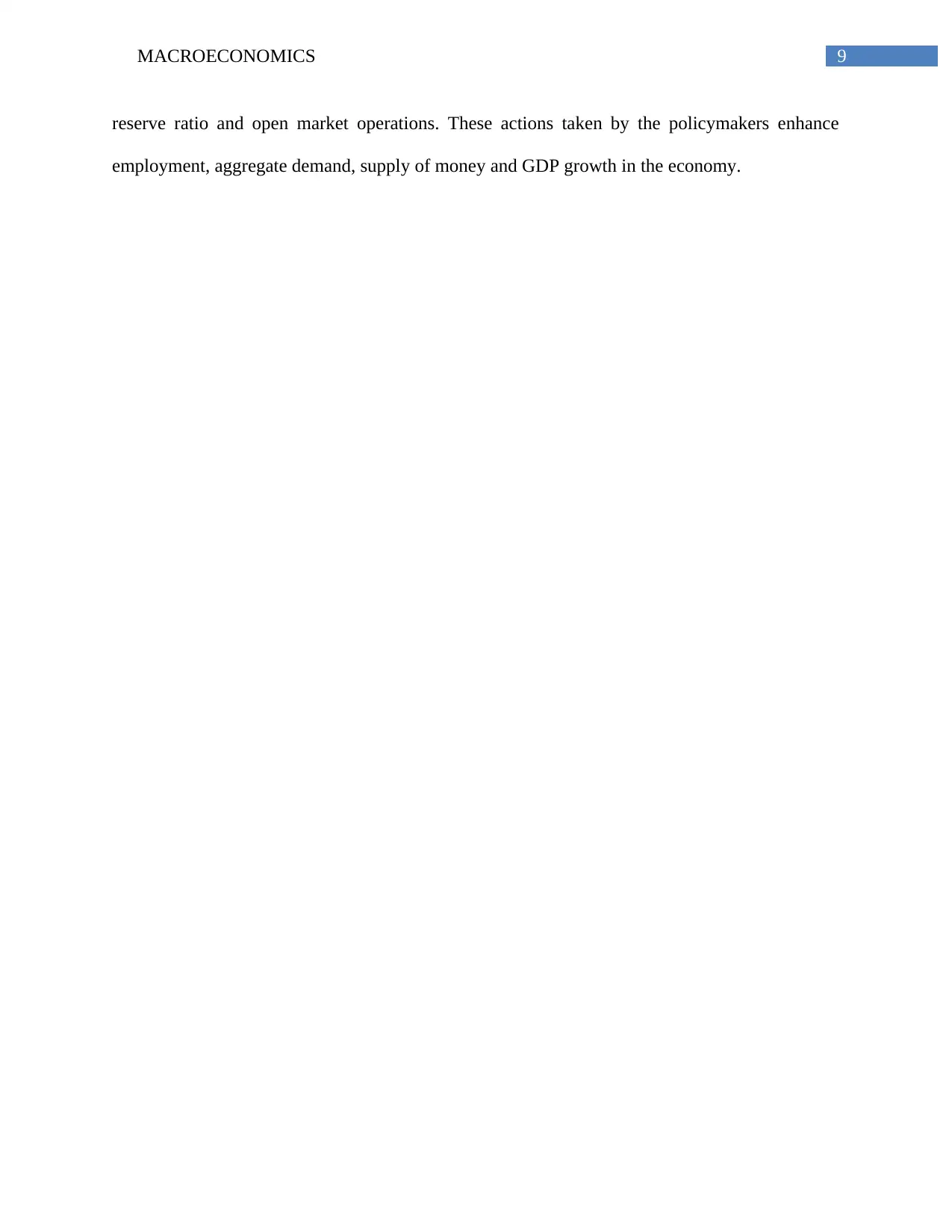
9MACROECONOMICS
reserve ratio and open market operations. These actions taken by the policymakers enhance
employment, aggregate demand, supply of money and GDP growth in the economy.
reserve ratio and open market operations. These actions taken by the policymakers enhance
employment, aggregate demand, supply of money and GDP growth in the economy.
Paraphrase This Document
Need a fresh take? Get an instant paraphrase of this document with our AI Paraphraser
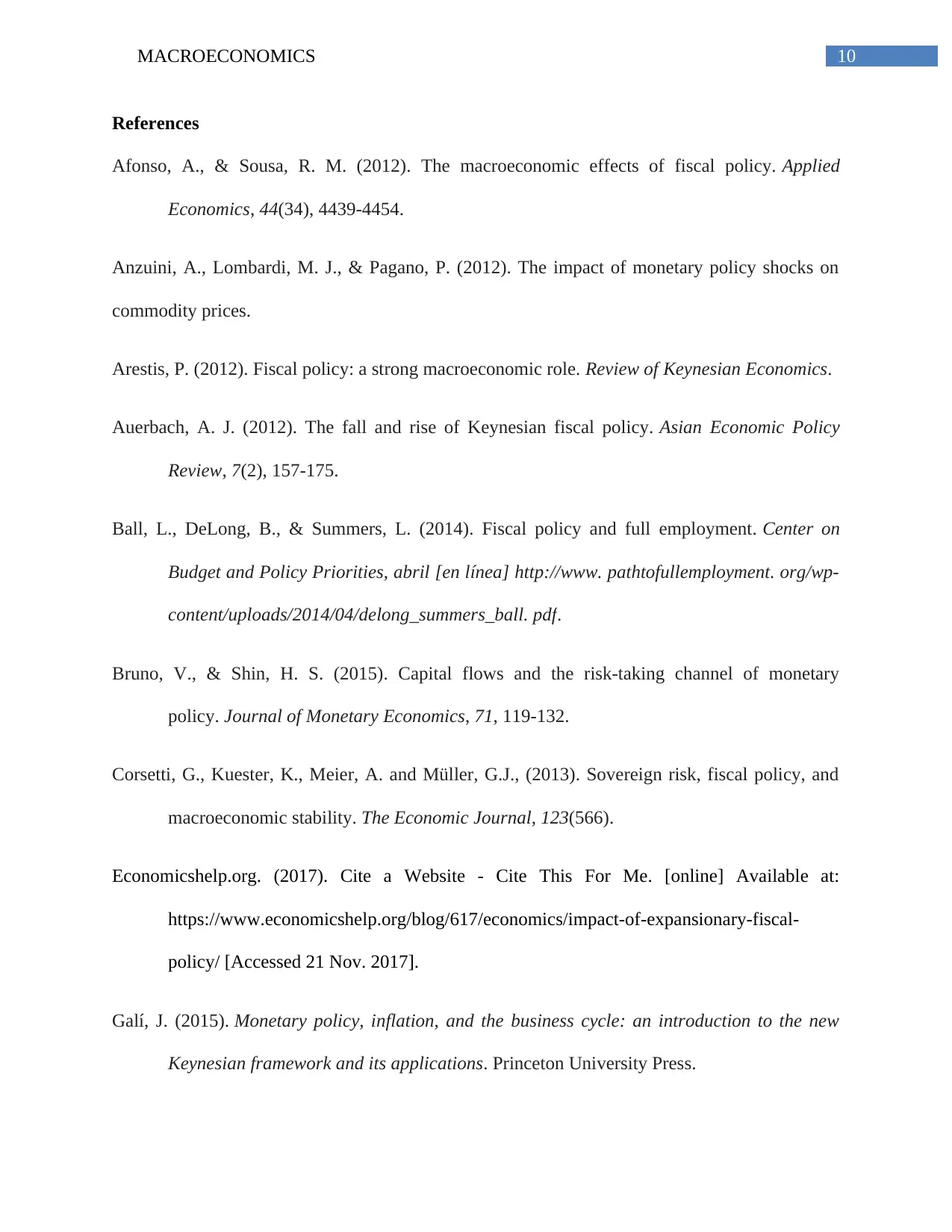
10MACROECONOMICS
References
Afonso, A., & Sousa, R. M. (2012). The macroeconomic effects of fiscal policy. Applied
Economics, 44(34), 4439-4454.
Anzuini, A., Lombardi, M. J., & Pagano, P. (2012). The impact of monetary policy shocks on
commodity prices.
Arestis, P. (2012). Fiscal policy: a strong macroeconomic role. Review of Keynesian Economics.
Auerbach, A. J. (2012). The fall and rise of Keynesian fiscal policy. Asian Economic Policy
Review, 7(2), 157-175.
Ball, L., DeLong, B., & Summers, L. (2014). Fiscal policy and full employment. Center on
Budget and Policy Priorities, abril [en línea] http://www. pathtofullemployment. org/wp-
content/uploads/2014/04/delong_summers_ball. pdf.
Bruno, V., & Shin, H. S. (2015). Capital flows and the risk-taking channel of monetary
policy. Journal of Monetary Economics, 71, 119-132.
Corsetti, G., Kuester, K., Meier, A. and Müller, G.J., (2013). Sovereign risk, fiscal policy, and
macroeconomic stability. The Economic Journal, 123(566).
Economicshelp.org. (2017). Cite a Website - Cite This For Me. [online] Available at:
https://www.economicshelp.org/blog/617/economics/impact-of-expansionary-fiscal-
policy/ [Accessed 21 Nov. 2017].
Galí, J. (2015). Monetary policy, inflation, and the business cycle: an introduction to the new
Keynesian framework and its applications. Princeton University Press.
References
Afonso, A., & Sousa, R. M. (2012). The macroeconomic effects of fiscal policy. Applied
Economics, 44(34), 4439-4454.
Anzuini, A., Lombardi, M. J., & Pagano, P. (2012). The impact of monetary policy shocks on
commodity prices.
Arestis, P. (2012). Fiscal policy: a strong macroeconomic role. Review of Keynesian Economics.
Auerbach, A. J. (2012). The fall and rise of Keynesian fiscal policy. Asian Economic Policy
Review, 7(2), 157-175.
Ball, L., DeLong, B., & Summers, L. (2014). Fiscal policy and full employment. Center on
Budget and Policy Priorities, abril [en línea] http://www. pathtofullemployment. org/wp-
content/uploads/2014/04/delong_summers_ball. pdf.
Bruno, V., & Shin, H. S. (2015). Capital flows and the risk-taking channel of monetary
policy. Journal of Monetary Economics, 71, 119-132.
Corsetti, G., Kuester, K., Meier, A. and Müller, G.J., (2013). Sovereign risk, fiscal policy, and
macroeconomic stability. The Economic Journal, 123(566).
Economicshelp.org. (2017). Cite a Website - Cite This For Me. [online] Available at:
https://www.economicshelp.org/blog/617/economics/impact-of-expansionary-fiscal-
policy/ [Accessed 21 Nov. 2017].
Galí, J. (2015). Monetary policy, inflation, and the business cycle: an introduction to the new
Keynesian framework and its applications. Princeton University Press.

11MACROECONOMICS
Hansen, A. H. (2013). Fiscal policy & business cycles. Routledge.
lumenlearning.com. (2017). Impacts of Federal Reserve Policies | Boundless Economics.
[online] Available at:
https://courses.lumenlearning.com/boundless-economics/chapter/impacts-of-federal-
reserve-policies/ [Accessed 21 Nov. 2017].
Mankiw, N. G. (2014). Principles of macroeconomics. Cengage Learning.
Wu, J. C., & Xia, F. D. (2016). Measuring the macroeconomic impact of monetary policy at the
zero lower bound. Journal of Money, Credit and Banking, 48(2-3), 253-291
Yelena, F., & Takhtamanova, E. (2012). The economic outlook and monetary policy.
Hansen, A. H. (2013). Fiscal policy & business cycles. Routledge.
lumenlearning.com. (2017). Impacts of Federal Reserve Policies | Boundless Economics.
[online] Available at:
https://courses.lumenlearning.com/boundless-economics/chapter/impacts-of-federal-
reserve-policies/ [Accessed 21 Nov. 2017].
Mankiw, N. G. (2014). Principles of macroeconomics. Cengage Learning.
Wu, J. C., & Xia, F. D. (2016). Measuring the macroeconomic impact of monetary policy at the
zero lower bound. Journal of Money, Credit and Banking, 48(2-3), 253-291
Yelena, F., & Takhtamanova, E. (2012). The economic outlook and monetary policy.
⊘ This is a preview!⊘
Do you want full access?
Subscribe today to unlock all pages.

Trusted by 1+ million students worldwide
1 out of 12
Related Documents
Your All-in-One AI-Powered Toolkit for Academic Success.
+13062052269
info@desklib.com
Available 24*7 on WhatsApp / Email
![[object Object]](/_next/static/media/star-bottom.7253800d.svg)
Unlock your academic potential
Copyright © 2020–2025 A2Z Services. All Rights Reserved. Developed and managed by ZUCOL.





